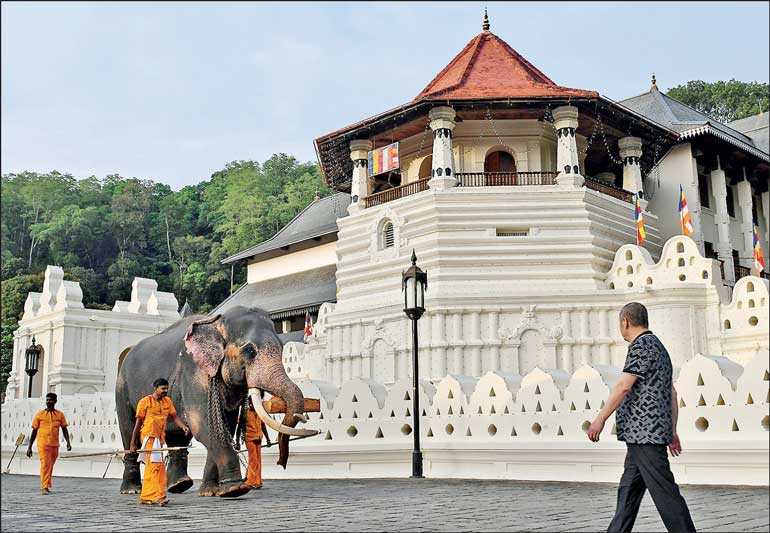Monday Mar 10, 2025
Monday Mar 10, 2025
Tuesday, 10 December 2019 00:00 - - {{hitsCtrl.values.hits}}

It was early this year that the proposal was made to declare the Theravada Tripitaka, sacred scripture of Buddhists or commonly called ‘three baskets of Dhamma,’ as a UNESCO World Heritage. This was supported by all the Buddhist countries in the world.
The proposal is also a recognition of the Maha Sangha for preserving Dhamma for centuries and by a declaration of this noble inheritance as a world heritage, Sri Lanka will no doubt receive trusteeship of it and a place where thousands of visitors from other countries can benefit from spiritual healing.
Prof. Senerath Paranavithana, the renowned and pioneering archaeologist and epigraphist, once referred to the value of the Tripitaka as “the greatest contribution that the Sri Lankan people had made to the intellectual heritage of mankind”.
According to scriptures, the Tripitaka was written down during the latter part of the 1st century BC when the whole country was disrupted by foreign invasions followed by unprecedented famine. Until then it was the oral tradition from generation to generation of Maha Sangha.
It is in this background the writer wishes to amplify the potential of developing spiritual tourism for Sri Lanka by offering the visitors the gist of Buddhist philosophy advocating meditation which comes under two main sections, viz. Samatha and Vidharshana.
One might raise the question why Buddhist philosophy and mediation have not become the biggest tourist attraction in Sri Lanka since the advent of Buddhism in this country. This question comes at a time when most Westerners are moving towards spiritual practices including Buddhist meditation on tranquillity or mindfulness.
There are however impediments to the efforts of spreading the Dhamma among tourists in Sri Lanka. It is time this matter was taken seriously when the Tripitaka is poised to be announced as a World Heritage. Thailand, Laos, and Cambodia being Theravada Buddhist countries would also be beneficiaries.
There is a lack of interest among many tour operators to include in tour itineraries an optional program for a spiritual discussion and meditation. The tourists staying in a resort hotel are offered many facilities from a fitness centre, library, spa, business lounge with free Wi-Fi, sightseeing, to bicycle rides, etc. but no place for meditation and a teacher.
The availability of English speaking meditation or spiritual teachers is difficult hence the need to work on this through educational institutions. Until the language skills are developed the teachers could engage interpreters and the interpreters will be groomed to become teachers later.
For many decades pilgrim travel and spiritual travel were identified as one activity until the true definition of spiritual travel implicitly surfaced in global travel. Pilgrim travel essentially visits to places of religious significance or to practice an annual ritual. Sri Lankan Buddhists visiting Buddhist sites in India and Nepal, making or fulfilling vows at Thirupathy, South Indians travelling to Kataragama during festival or Christians to Jerusalem are examples of pilgrim travel.Tourists visiting the Temple of the Tooth Relic is neither spiritual tourism (because there is no motive for that purpose) nor pilgrim tourism as the visits are not devotional but only with respect and to pay homage. Hindus from Gujarat and Andra Pradesh are taking tours to Ramayana sites in Sri Lanka which could be called pilgrim travel that Sri Lanka tourism has promoted from time to time.
Spiritual tourism can be defined as travel by people who are desirous of seeking inner peace and liberating themselves from psychological suffering. This is the segment that is growing fast worldwide which needs to be viewed in relation to its potential for Sri Lanka, which should be worth researching further.
Spiritual tourism has been directly linked to yoga in India and Bali. More and more hotels are offering yoga classes in Bali and with yoga festivals, Bali has positioned itself as a unique location for Yoga in which, meditation is embedded as a key component.
The West, a primary market for Sri Lanka tourism, has been keen to learn Eastern philosophy and some of the participants in the ’80s and ’90s have become spiritual teachers today who travel around the world offering discourses and mediations. Adyashanti, Gangaji, Tony Parsons, Jim Newman, Naho Owada, and Richard Sylvester, to name some. At the same time personalities like Mooji have developed own places like Monte Sahaja in Portugal where thousands gather through short haul travel especially from Europe.
Over 40 million visitors travel around the world especially from the West seeking some form of wellness, be it Ayurveda, yoga or meditation or as a combination. Records show over 17 million adults in the United States engage in some spiritual practices including yoga. All Sri Lanka needs is a fraction of them bearing in mind that such spiritual seekers do not mind the long-haul journey with transits if they get the right message, right service in the right atmosphere from right people. There is no price for spiritual freedom.
Taking Bali and Indian practices into consideration, Sri Lanka needs to distinguish the product offering. Meditation is a vital aspect in spiritual tourism either as an independent component or as a part of a yoga or Ayurveda retreat.
Theravada tradition offers 40 types of Samatha meditation. The most popular meditations are the breathing meditation and meditation on loving kindness. While these practices help settling down of the mind, there is a need to extract teachings of supra mundane sector of Buddhism through Vidharshana or Insight Meditation. The Western teachers have skilfully used these to put across right messages to their audiences in eloquent language.
Monasteries such as Amarawathi in the UK and Wat Poh Nanachat in Thailand offer Buddhist meditation practices. They have not attracted large numbers due to the rigorous nature of training. The lay preachers have proven that short discourses of supra mundane teachings had tremendous impact on participants for inner transformation.
The Vipassana or insight teachings are meant for the seekers to engage in an inward journey attempting to identify the nature of self, meaning the understanding of thoughts, sensations, feelings and emotions that are the basics forming the self and the story of self. The theme that has been advocated by them is truth is simple and it is too simple that most people miss the obvious!
The word liberation is a key phrase used in spirituality. In Buddhism it is called freedom from suffering which many humans begin to see in the old age when there is nothing more to achieve. All material gains or egoic positions will be necessary for existence, but no one carries them after their life sojourn.
However, if this message is communicated as it is in toto, it would be construed as negative for tourists when there is a huge corporate market for motivational and leadership programs backed by positive thinking. This is where the western teachers have succeeded in distinguishing peace and happiness. Spiritual programs do not demand special facilities. There are thousands of Buddhist temples alone the routes of itineraries. One obstacle apart from language skills is that these temples are catering to the needs of the local community which includes traditions and rituals that are emanating from the culture.
Another crucial factor is the identification of right messages that needs to be communicated to target audiences. Some research is needed as to what happens outsider Sri Lanka with humility as we are speaking about offering the Dhamma to foreigners. This must be beyond good and bad, right and wrong which they have inculcated through their legal systems and ethical practices in their countries.
What they are looking for is a teaching that has not been hither to heard for inner transformation to have peace that undoubtedly requires removing of the layers that form the false self and a temporary stories (ending up in Wikipedia or perhaps not even in that) and opening the door for childlike wonder, as against happiness that can derive from material gains.
Buddhist philosophy offers the choice and what the industry needs is to make it available to the visitors. Sadly, the discussion is still at conceptual level while the potential has been overlooked for over half a century since the arrival of tourists from Scandinavia in charter flights in the ’60s.
(The writer is formerly a diplomat, tourism official and currently an academic.)
Discover Kapruka, the leading online shopping platform in Sri Lanka, where you can conveniently send Gifts and Flowers to your loved ones for any event including Valentine ’s Day. Explore a wide range of popular Shopping Categories on Kapruka, including Toys, Groceries, Electronics, Birthday Cakes, Fruits, Chocolates, Flower Bouquets, Clothing, Watches, Lingerie, Gift Sets and Jewellery. Also if you’re interested in selling with Kapruka, Partner Central by Kapruka is the best solution to start with. Moreover, through Kapruka Global Shop, you can also enjoy the convenience of purchasing products from renowned platforms like Amazon and eBay and have them delivered to Sri Lanka.
Discover Kapruka, the leading online shopping platform in Sri Lanka, where you can conveniently send Gifts and Flowers to your loved ones for any event including Valentine ’s Day. Explore a wide range of popular Shopping Categories on Kapruka, including Toys, Groceries, Electronics, Birthday Cakes, Fruits, Chocolates, Flower Bouquets, Clothing, Watches, Lingerie, Gift Sets and Jewellery. Also if you’re interested in selling with Kapruka, Partner Central by Kapruka is the best solution to start with. Moreover, through Kapruka Global Shop, you can also enjoy the convenience of purchasing products from renowned platforms like Amazon and eBay and have them delivered to Sri Lanka.